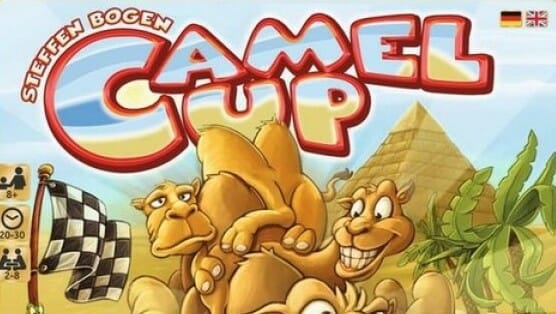Camel Up Boardgame: Gambling Fun for the Whole Family

Camel Up won the 2014 Spiel des Jahres (Game of the Year) award, a prestigious honor previously bestowed on classics like Settlers of Catan and Dominion The choice was notable because Camel Up is so unlike the games that have won this award in the past. Camel Up is very much a family game, a light strategy offering with a heavy randomness component, the type of game you play entirely for fun and will only dislike if you start to take it too seriously. It is seriously fun, if you’re into that sort of thing, but the gamer who prefers Agricola and Caylus will consider Camel Up a trifle for the kids.
The Camel Up itself is a camel race around a small track of sixteen spaces, with five camels of different colors vying for the title. From two to eight players play bettors on the race, and can place short- and long-term wagers on which camels will finish first or second in a specific leg of the race, or which camels will finish first or last overall when the race ends. That means players aren’t tied to specific camels—you can bet on the orange camel to win one leg, the green to win the next one, and the blue to win the whole thing. Betting is fluid and should include what other players are doing as well as where you think the camels are headed. When the game ends, the final bets are tallied and the player with the most money is the winner.
The way the camels move is the game’s most unique mechanic. Each camel is represented by a die with the values 1, 2 and 3 (on two sides apiece), and all five dice go into a cardboard pyramid that, when placed upside down on a hard surface, will allow for the release of just one die. Therefore, one camel moves per die roll—the player choosing to use the pyramid and roll the dice gets one pound coin as an incentive—and when all five dice have been rolled, that completes one “leg” of the race, and all bets on that particular leg are scored. The dice return to the pyramid, the leg betting cards return to the board, and the next leg begins.
The camel tokens—they’re meeple-like, but I can’t call them meeples—are stackable, so when two camels occupy the same space on the track, they form a little tower of camels. When a camel with one or more others on its back moves, he carries all of them forward, so a camel of one color may hitch a ride on another’s back before its own die has come out of the pyramid on that particular leg. Working out how each camel might move on that leg is probably the game’s biggest thought component, and playing it with my eight-year-old daughter, I noticed that was the part that most engaged her brain. She was secretly enjoying working that out and getting the right answer.
-

-

-

-

-

-

-

-

-

-

-

-

-

-

-

-

-

-

-

-

-

-

-

-

-

-

-

-

-

-

-

-

-

-

-

-

-

-

-

-










































